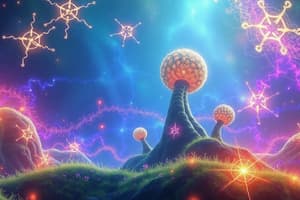Podcast
Questions and Answers
What are the eight characteristics of life used to distinguish living organisms from nonliving things?
What are the eight characteristics of life used to distinguish living organisms from nonliving things?
Cellular makeup, reproduction, growth and development, metabolism, irritability, adaptation and evolution, movement, homeostasis.
What is the smallest, basic unit of matter?
What is the smallest, basic unit of matter?
Atom
Which of the following are levels of biological organization? (Select all that apply)
Which of the following are levels of biological organization? (Select all that apply)
- Tissue (correct)
- Network
- Organ (correct)
- Cell (correct)
Prokaryotic cells have membrane-bound organelles.
Prokaryotic cells have membrane-bound organelles.
What are the two types of cells mentioned in the text?
What are the two types of cells mentioned in the text?
What forms when similar cells combine to perform similar functions?
What forms when similar cells combine to perform similar functions?
Match the following biological structures with their functions:
Match the following biological structures with their functions:
What is an organism?
What is an organism?
Study Notes
Levels of Biological Organization
- The hierarchy of life starts from atoms, the smallest unit of matter, to molecules, leading to cells, tissues, organs, organ systems, and organisms.
- Cells are the basic structural and functional units of life, which can be unicellular or multicellular.
- Organelles within cells support their structure and function; cells can be either prokaryotic (no membrane-bound nuclei) or eukaryotic (membrane-bound organelles).
Characteristics of Living Organisms
- Eight key characteristics distinguish living organisms from nonliving entities: cellular makeup, reproduction, growth and development, metabolism, irritability, adaptation and evolution, movement, and homeostasis.
- The complexity and organization of living organisms arise from their cellular structure and the interactions between different levels of biological organization.
Tissues and Organs
- Similar cells combine to form tissues, which perform specific functions; common examples include smooth muscle, cardiac muscle, and vascular tissue in plants.
- Tissues group together to form organs (e.g., heart, liver, plant roots, leaves) that fulfill broader physiological roles.
Organ Systems and Organisms
- Organs that work together form organ systems, such as the circulatory system, which includes the heart and blood vessels to transport blood.
- An individual entity, such as a plant or animal, is referred to as an organism, with bacteria classified as microorganisms.
Emerging Properties
- At each level of biological organization, emergent properties arise that are unique to that level— characteristics that cannot be predicted merely from the lower levels.
- Structure-function correlation is evident as the design of each level is critical to its function, emphasizing the importance of organization in biological systems.
Studying That Suits You
Use AI to generate personalized quizzes and flashcards to suit your learning preferences.
Related Documents
Description
Test your understanding of the levels of biological organization in this Integrated Science 2 quiz. This module aims to help you differentiate between various biological levels and understand their significance in the study of life. Get ready for a 30-minute challenge!




